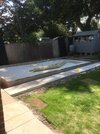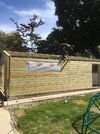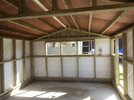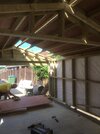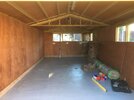Hiya,
I'm replacing a "package" 10' x 20' shed and will be building it from scratch. The quality of the shed was not high in the first place, and it's now leaking and generally damp, and is also not well organised. I'm moderately experienced in building larger projects (I've designed and built a 5m x 7m raised, roofed decking from scratch).
There is an existing 6m x 3m concrete base that will be good enough, and I'm intending to build this from predominantly 4x2s in order to keep the walls strong enough for mounting things on, as well as the extra affordance that will offer for in-wall insulation above 3x2s. I will be splitting the shed down the middle, in order to optimise wall storage, and also to clearly separate the storage area for bikes, garden furniture, garden tools from the workshop with power/hand tools and possibly cycle maintenance area.
The advice I would like is around the weather/damp proofing of the building. I'm pretty certain the slab was laid over DPM (I can see some of it at the edges, so I can only assume it's a "good" layer), but I'm not certain what's best to do above that. Does anyone have any advice or know of any good resources for how best to design the floor, walls, roof of a garden building to minimise heat-loss and - more importantly - to prevent damp inside the building. I have mains power to the existing shed, so I was hoping to have tubular heaters in each section to help keep it above the dew point in there.
Things I've been thinking about so far:
- Raising the building off the base (e.g. building on top of 2x2 runners)
- Bolting the main building to the base for strength, but then putting a DPM across the floor with insulation and flooring on top (e.g. celotex + laminate)
- Do I need a VCL on the walls?
- What cladding would be best ... is shiplap sufficient, and I presume I will want to make sure the outer extent of the cladding is beyond the base to prevent run-off?
- Would a breather membrane under the cladding be necessary?
- If I'm trying to keep to the 2.5m limit (it's only 1m from the boundary), is there any roof design that's optimal, considering I want >1.9m doors in the long edge of the building?
Thank you so much for any advice people can offer ... I realise I could just crack on and build it however and it would be fine, but there's a lot of unknown unknowns for me in this currently!
I'm replacing a "package" 10' x 20' shed and will be building it from scratch. The quality of the shed was not high in the first place, and it's now leaking and generally damp, and is also not well organised. I'm moderately experienced in building larger projects (I've designed and built a 5m x 7m raised, roofed decking from scratch).
There is an existing 6m x 3m concrete base that will be good enough, and I'm intending to build this from predominantly 4x2s in order to keep the walls strong enough for mounting things on, as well as the extra affordance that will offer for in-wall insulation above 3x2s. I will be splitting the shed down the middle, in order to optimise wall storage, and also to clearly separate the storage area for bikes, garden furniture, garden tools from the workshop with power/hand tools and possibly cycle maintenance area.
The advice I would like is around the weather/damp proofing of the building. I'm pretty certain the slab was laid over DPM (I can see some of it at the edges, so I can only assume it's a "good" layer), but I'm not certain what's best to do above that. Does anyone have any advice or know of any good resources for how best to design the floor, walls, roof of a garden building to minimise heat-loss and - more importantly - to prevent damp inside the building. I have mains power to the existing shed, so I was hoping to have tubular heaters in each section to help keep it above the dew point in there.
Things I've been thinking about so far:
- Raising the building off the base (e.g. building on top of 2x2 runners)
- Bolting the main building to the base for strength, but then putting a DPM across the floor with insulation and flooring on top (e.g. celotex + laminate)
- Do I need a VCL on the walls?
- What cladding would be best ... is shiplap sufficient, and I presume I will want to make sure the outer extent of the cladding is beyond the base to prevent run-off?
- Would a breather membrane under the cladding be necessary?
- If I'm trying to keep to the 2.5m limit (it's only 1m from the boundary), is there any roof design that's optimal, considering I want >1.9m doors in the long edge of the building?
Thank you so much for any advice people can offer ... I realise I could just crack on and build it however and it would be fine, but there's a lot of unknown unknowns for me in this currently!


